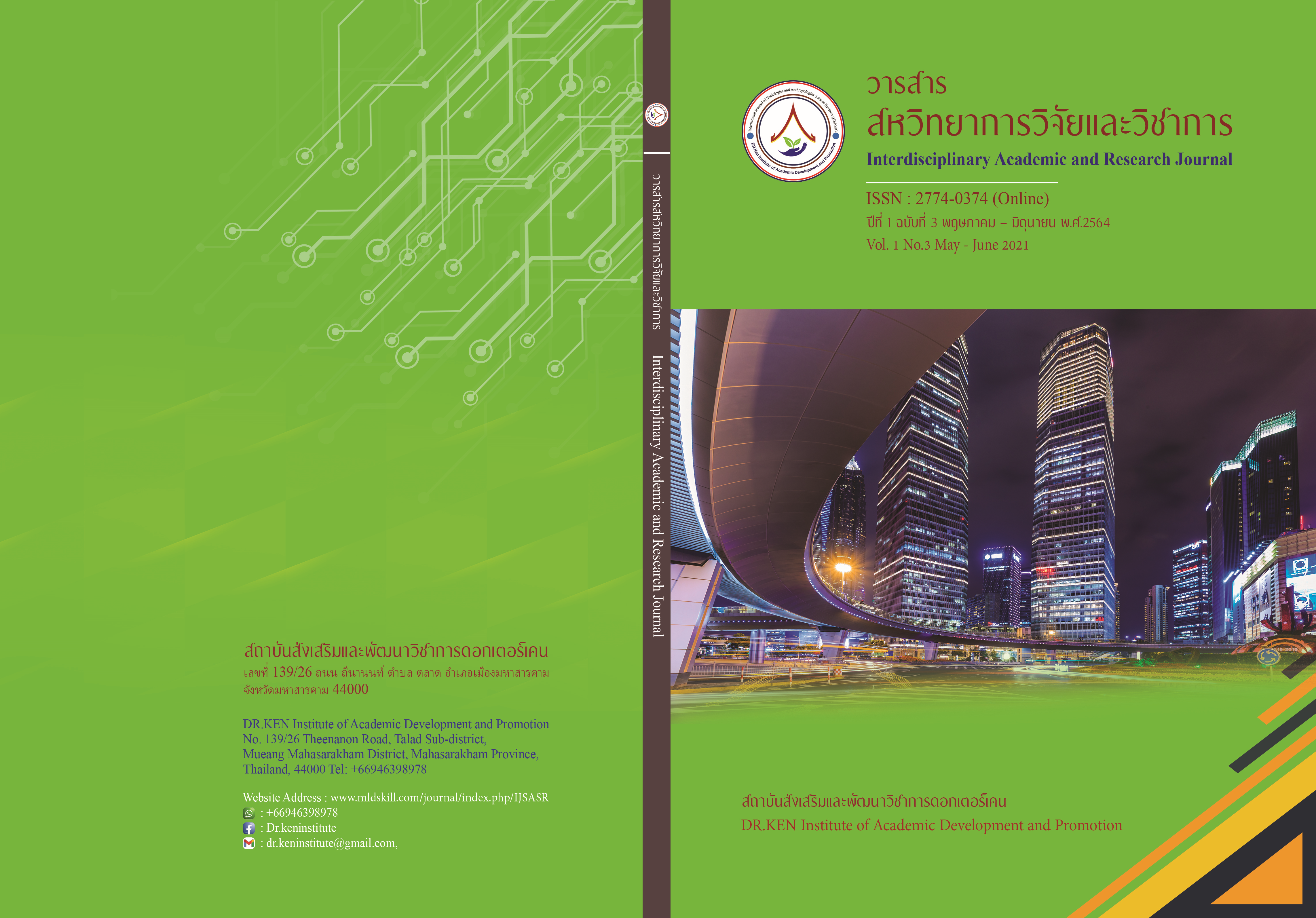Causal Factors Influencing Cross-cultural Understanding in 21st Century Human Skills of Mathayom Susa 1 in Marginalized Secondary School Groups, Chiang Rai Province
DOI:
https://doi.org/10.14456/iarj.2021.12Keywords:
Causal Factors Influencing; Cross-cultural Understanding in 21st-Century Human Skills; Marginalized Secondary SchoolAbstract
Human being made culture and continue to make culture for their survival and comfort in the community. As the community expands, there will be cultural diversity. The school is a large multicultural, especially the marginal schools in the north of Thailand, where there is cultural diversity of ethnic people. The study of relevant documents found that culture affects human being and their educations. Thus, the researcher is interested in studying causal factors influencing cross-cultural understanding in 21st-century human skills of Mathayom Suksa 1 in marginalized secondary school groups, Chiang Rai province. The objectives of this research were to examine the consistency of the developed model with the empirical data and to study the combined influence, direct influence, indirect influence to cross-cultural understanding in 21st-century human skills of Mathayom Suksa 1 in marginalized secondary school groups, Chiang Rai province. The samples were 306 students. They were selected by a simple random sampling technique. The research instrument was a questionnaire about causal factors influencing cross-cultural understanding in 21st-century human skills of Mathayom Suksa 1 in marginalized secondary school groups, Chiang Rai province which consisted of teaching, policy, cooperation, attitude, and cross-cultural understanding in 21st-century human skills. The data were analyzed by Mean, Standard Deviation, and the analysis of the path results of research. The result showed that:
1. The developed model is consistent with empirical data. When considering the criteria found that x2= 25.44, df = 44, p = 0.99, GFI = 0.99, AGFI = 0.97, RMR = 0.019, RMSEA = 0.00 and CFI = 1.00.
2. The highest score of combined influence to cross-cultural understanding in 21st-century human skills of Mathayom Suksa 1 in marginalized secondary school groups, Chiang Rai province was teaching, the highest score of direct influence was cooperation and the highest score of indirect influence was policy.
References
กมลชนก ชำนาญ.(2557). การพัฒนาแบบวัดและการวิเคราะห์ระดับความสามารถทางวัฒนธรรมของครู.วารสารอิเล็กทรอนิกส์ทางการศึกษา ฉบับที่ 2 534-548.
กิตติวินท์ เดชชวนากร.(2559).การอยู่ร่วมกันในสังคมพหุวัฒนธรรม กรณีศึกษา : ตำบลร่มเย็น อำเภอเชียงคำ จังหวัดพะเยา. วิทยานิพนธ์ปริญญาดุษฎีบัณฑิต สาขาพหุวัฒนธรรมศึกษา คณะศึกษาศาสตร์ :มหาวิทยาลัยเชียงใหม่
ขวัญสุดา วงษ์แหยม.(2560).การบริหารจัดการการศึกษาของสถานศึกษา ที่ตั้งอยู่ในชุมชนพหุวัฒนธรรม ของเกาะเมืองพระนครศรีอยุธยา.วารสารบัณฑิตวิทยาลัยสวนดุสิต. 13 (3), 127-146.
ทิฆัมพร สมพงษ์. (2559). รูปแบบการบริหารสถานศึกษาตามแนวคิดพหุวัฒนธรรมศึกษาในสามจังหวัดชายแดนภาคใต้ . สงขลา: มหาวิทยาลัยสงขลานครินทร์.
นุชนารถ รัตนสุวงศ์ชัย. (2547). การสื่อสารข้ามวัฒนธรรมสาหรับงานบริการ. วารสารมนุษยศาสตร์, 12, 83 - 94.
บัญญัติ ยงย่วน และชัยวัฒน์ ผดุงพงษ์. (2550). การใช้กิจกรรมศิลปะเพื่อส่งเสริมการยอมรับความหลากหลายวัฒนธรรมในสังคมพหุวัฒนธรรม. วารสารศึกษาศาสตร์ มหาวิทยาลัยสงขลานครินทร์ ปัตตานี,18 (1), 1-14.
บัญญัติ ยงย่วน และชัยวัฒน์ ผดุงพงษ์. (2553). การใช้กิจกรรมศิลปะเพื่อส่ง เสริมการยอมรับความหลากหลายวัฒนธรรมของนักเรียนชั้นประถมศึกษา จังหวัดปัตตานี. วารสารสงขลานครินทร์ ฉบับสังคมศาสตร์และมนุษยศาสตร์, 16 (6), 953-972.
บัญญัติ ยงย่วน. (2551). การส่งเสริมพัฒนาเด็กในบริบทของความหลากหลายวัฒนธรรม : 10 ปี ทศวรรษเพื่อเด็กและภูมิปัญยาของครอบครัว. นนทบุรี : มหาวิทยามหิดล, พริ้นติ้งแอนด์พลับลิซซิง จำกัด.
บัญญัติ ยงย่วน. (2555).รูปแบบการจัดการศึกษาพหุวัฒนธรรมในโรงเรียนประถมศึกษา. บทความวิชาการเพื่อเด็กและภูมิปัญญาของครอบครัว. นครปฐม: มหาวิทยาลัยมหิดล.
พิสิทธิ์ พิพัฒน์โภคากุล. (2559).วัฒนธรรมการบริการ.วารสารวิทยาลัยดุสิตธานี. 10 (1), 283-295.
มุจลินทร์ ผลกล้า. (2553). วัตถุประสงค์หลักของพหุวัฒนธรรมศึกษา. (Online). สืบค้นเมื่อวันที่ 15 มีนาคม 2554 สืบค้นจาก http://gotoknow.org/blog/moolin/340006
ยุทธ ไกยวรรณ์. (2551). การเลือกใช้สถิติที่เหมาะสม. กรุงเทพฯ: ศูนย์สื่อเสริมกรุงเทพ.
รสสุคนธ์ เนาวบุตร และนรินทร์ สังข์รักษา. (2558) แนวทางการจัดการศึกษาเรียนร่วมพหุวัฒนธรรม: กรณีศึกษาชุมชนป่าละอู อำเภอหัวหิน จังหวัดประจวบคีรีขันธ์. Veridian E-Journal Silpakorn University ฉบับภาษาไทย สาขามานุษยวิทยา สังคมศาสตร์ และศิลปะ, 8 (1), 420-435).
สมบัติ ธำรงธัญวงศ์. (2558).วัฒนธรรมทางการเมือง.การเมือง แนวความคิดและการพัฒนา. .(พิมพ์ครั้งที่ 22)โครงการเอกสารและตำรา คณะรัฐประศาสนศาสตร์ สถาบันบัณฑิตพัฒนบริหารศาสตร์. กรุงเทพฯ.
สมบัติ ธำรงธัญวงศ์. (2559). ปัจจัยที่มีผลต่อการประยุกต์นโยบายส่งเสริมความหลากหลายทางวัฒนธรรมของอาเซียน.วาสารสังคมศาสตร์. 46 (1), 161-180.
สันติ บูรณะชาติ. (2558). การจัดการศึกษาในยุคประชาคมอาเซียนตามแนวทางพหุวัฒนธรรมศึกษา. วิทยานิพนธ์ปริญญามหาบัญญิต สาขาวิชาการศึกษา วิทยาลัยการศึกษา : มหาวิทยาลัยพะเยา.
สำราญ มีแจ้ง. (2544). การใช้สถิติสำหรับการวิจัย. กรุงเทพฯ : นิชินแอดเวอร์ไทซิ่งกรุ๊ฟ.
สิริวรรณ ศรีพหล. (2555). การพัฒนาระบบการจัดการเรียนการสอนทางไกล เรื่อง พหุวัฒนธรรม สำหรับครูสังคมศึกษา. วิทยานิพนธ์ปริญญามหาบัณฑิต สถาบันวิจัยและพัฒนา: มหาวิทยาลัยสุโขทัยธรรมาธิราช.
สุทัศน์ สังคะพันธ์. (2557). ทำไมต้องทักษะในศตวรรษที่ 21 ในบทความทักษะแห่งศตวรรษที่ 21. นิสิตปริญญาเอก หลักสูตรและการสอน : มหาวิทยาลัยมหาสารคาม.
อนันต์ แย้มเยื้อน.(2559).โมเดลความสัมพันธ์เชิงสาเหตุของการปรบตัวเพื่อเข้าสู่ประชาคมเศรษฐกิจอาเซียน ของนักศึกษามหาวิทยาลัยราชภัฏเขตภาคเหนือตอนล่าง. Souteast Bangkok Journal, 1-15.
Dupraw and Axner: 1997. Working on common Cross-culture Communication Challenges. [Online]. http:22www.pbs.org2ampu2crosscult.html. [สืบค้นเมื่อ 23 เมษายน 2562]
Ford, D. Y., & Whiting, G. W. (2008). Cultural Competence: Preparing Gifted Students for a Diverse Society. Roeper Review, 30 (2), 104-110.
Downloads
Published
How to Cite
Issue
Section
License
Copyright (c) 2021 Interdisciplinary Academic and Research Journal ISSN 2774-0373 (Online)

This work is licensed under a Creative Commons Attribution-NonCommercial-NoDerivatives 4.0 International License.
Copyright on any article in the Interdisciplinary Academic and Research Journal is retained by the author(s) under the under the Creative Commons Attribution-NonCommercial-NoDerivatives 4.0 International License. Permission to use text, content, images, etc. of publication. Any user to read, download, copy, distribute, print, search, or link to the full texts of articles, crawl them for indexing, pass them as data to software, or use them for any other lawful purpose. But do not use it for commercial use or with the intent to benefit any business.
















.png)


